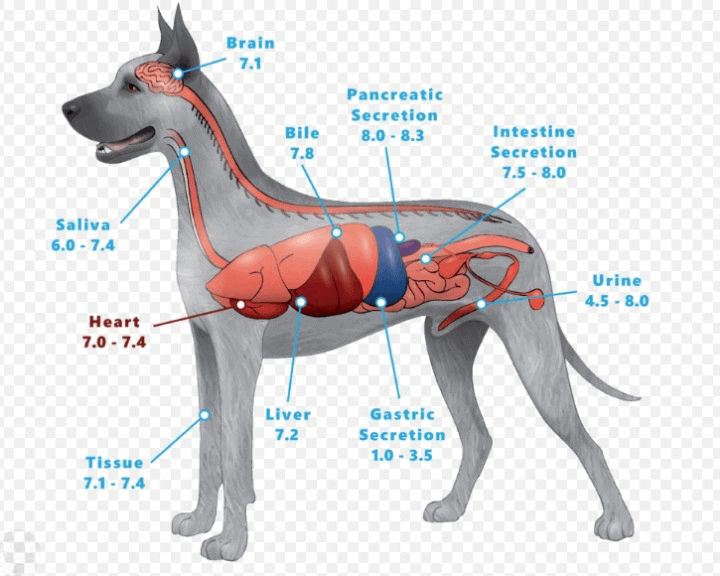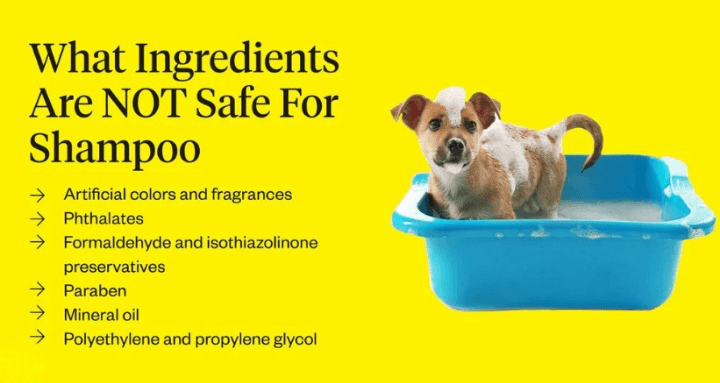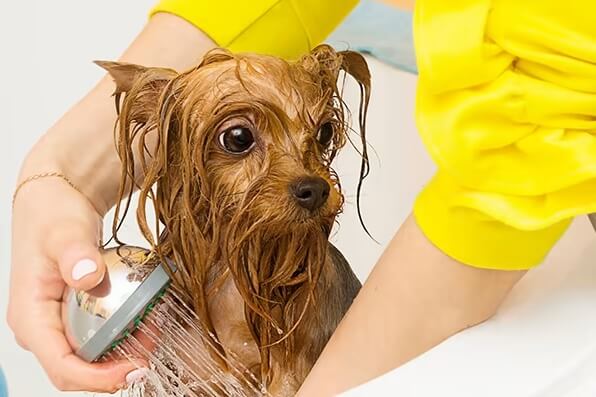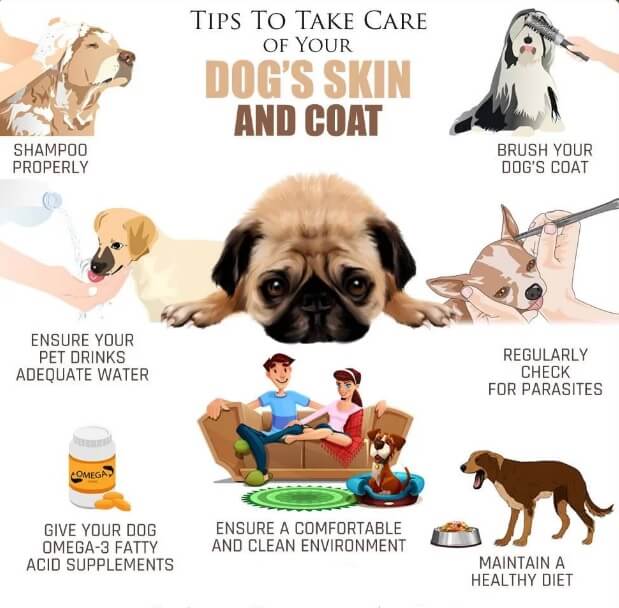The cleanliness and hygiene of our canine companions are a crucial aspect of responsible pet ownership. One particular consideration is the choice of shampoo used during bathing routines. While human shampoos may seem like a convenient option, it is important to evaluate their suitability for dogs.
This article examines if can dogs use human shampoo by comparing the differences in pH levels between human and canine skin, exploring potential risks associated with using human products on dogs, and providing recommendations for dog shampoos or alternatives that ensure optimal care.
Additionally, proper bathing techniques and practices for maintaining a healthy coat and skin will be discussed. By juxtaposing the pH levels, risks, and appropriate alternatives between human and dog shampoos, this article aims to inform readers about the importance of selecting appropriate grooming products for their furry friends while considering their unique needs.
Key Takeaways
- Dogs should be bathed regularly using mild dog shampoos to avoid irritating their sensitive skin.
- Human shampoos may not be suitable for dogs and can cause skin issues.
- Using the right dog shampoo helps maintain a healthy coat and skin, reducing shedding and preventing matting.
- Regular grooming and proper shampooing also allow for early detection of any skin issues in dogs.
Understand the Differences in pH Levels
The variance in pH levels between human and canine skin necessitates a considerate approach when selecting appropriate shampoo for dogs. Understanding the importance of pH balance in pet grooming products is crucial to maintaining the overall health and well-being of our furry companions.
Canine skin has a more alkaline pH compared to human skin, which is slightly acidic. This difference in pH levels can lead to various common skin issues in dogs.

One of the main reasons why pH balance is essential in pet grooming products is because it helps maintain the natural protective barrier of the dog’s skin. The acid mantle, which is formed by sebum secreted by sebaceous glands, plays a vital role in protecting the skin from harmful bacteria and external irritants. Using shampoos with an inappropriate pH level can disrupt this delicate balance, leading to dryness, itching, and other dermatological problems.
Furthermore, certain skin issues commonly seen in dogs are directly related to their pH levels. For instance, atopic dermatitis, a chronic inflammatory condition characterized by intense itching and redness, is often associated with an imbalanced pH level on the surface of the skin. By using shampoos specifically formulated for dogs that help restore or maintain their natural pH balance, we can effectively address these common canine skin problems.
Potential Risks if Can Dogs Use Human Shampoo
Potential risks associated with employing shampoo intended for human use on canines include:
- Potential skin irritation
- Disruption of the dog’s natural pH balance
Human shampoos are formulated to match the pH level of human skin, which is slightly acidic, ranging from 4.5 to 5.5. However, dogs have a more alkaline pH level, typically ranging from 6 to 8. Using a shampoo with an incorrect pH level can strip away the natural oils that protect a dog’s skin and coat, leading to dryness and potential irritation.

Additionally, some ingredients commonly found in human shampoos may be harmful or irritating to dogs’ sensitive skin. Fragrances, dyes, and certain chemicals used in human shampoos may cause allergic reactions or further exacerbate existing skin conditions in dogs. It is important to note that even ‘gentle’ or ‘natural’ human shampoos may not necessarily be suitable for canine use due to differences in their formulation.
To ensure the well-being of your dog’s skin and coat, it is crucial to consult a veterinarian before using any products not specifically designed for canine use. A veterinarian can provide guidance on choosing a suitable shampoo based on your dog’s specific needs and recommend products that are gentle and safe for regular use without causing any potential skin irritations or imbalances in pH levels.
Recommended Dog Shampoos and Alternatives
One option for maintaining the cleanliness and health of canine skin and coat is to explore a range of specialized dog shampoos or alternative grooming products. These products are specifically formulated to meet the unique needs of dogs and can provide numerous benefits over using human shampoo.

Dog shampoos often contain dog-friendly ingredients that are gentle on their skin and coat, helping to prevent irritation or allergic reactions. Additionally, these shampoos are designed to maintain the pH balance of a dog’s skin, which differs from that of humans.
In recent years, there has been an increased interest in natural remedies for pet care. Many dog owners prefer using natural ingredients in their grooming routine as they believe it promotes overall wellness. Fortunately, there are several dog shampoos available that utilize natural remedies such as oatmeal, aloe vera, or tea tree oil. These ingredients have soothing properties that can alleviate itchiness or dryness on a dog’s skin while promoting healthy hair growth.
Proper Bathing Techniques for Dogs

To effectively bathe your furry companion, it is essential to master proper techniques that ensure a thorough cleaning and promote their overall well-being. Here are three important steps to follow when bathing your dog:
- Preparing the Bathing Area:
Before starting the bath, gather all necessary dog bathing accessories such as shampoo, conditioner, and a brush. Ensure that the water temperature is lukewarm and comfortable for your dog. It’s also helpful to place a non-slip mat in the tub or shower to prevent your pet from slipping. - Shampooing:
Wet your dog’s coat thoroughly with water, avoiding their eyes and ears. Apply a small amount of dog-specific shampoo and gently massage it into their fur using circular motions. Rinse off all the shampoo completely, ensuring no residue is left behind. - Drying Techniques:
Use a towel to gently pat dry your dog’s coat after they have been rinsed off completely. Avoid vigorous rubbing as it can cause tangling or skin irritation. If you prefer using a blow dryer, set it on low heat and keep it at least 12 inches away from your pet’s body.
By following these proper bathing techniques and taking care during each step of the process, you can ensure that your furry friend stays clean and healthy while enjoying bath time with you!
Maintaining a Healthy Coat and Skin for Dogs
Maintaining a healthy coat and skin for dogs involves implementing proper grooming practices and adhering to a regular bathing routine. Regular brushing is crucial in maintaining a dog’s coat as it helps remove dirt, debris, and dead hair while distributing natural oils that keep the coat shiny and healthy. It also stimulates blood flow to the skin, promoting overall skin health.

Incorporating a grooming routine into the dog’s schedule is essential for their well-being. This includes brushing their coat at least once or twice a week, depending on the breed and length of their fur. Additionally, regular bathing should be carried out using mild shampoos specifically formulated for dogs, as human shampoos may contain ingredients that can irritate their sensitive skin.
To emphasize the importance of maintaining a healthy coat and skin, consider the following table:
| Benefits of Maintaining Healthy Coat and Skin |
|---|
| 1. Enhanced appearance |
| 2. Reduced shedding |
| 3. Prevention of matting |
| 4. Early detection of skin issues |
By adhering to these grooming practices consistently, owners can ensure that their furry companions have clean coats free from tangles or mats while promoting optimal skin health. A well-maintained coat not only enhances physical appearance but also contributes to the overall comfort and happiness of dogs, allowing them to serve others with joy.
See Also:
- How Long Can Dogs Hold Their Pee
- Why Do Dogs Fart? Exploring the Canine Flatulence Phenomenon
- What Do Dog Ear Mites Look Like
- Do Mosquitoes Bite Dogs
- Can Humans Get Worms From Dogs
- Shivering in Dogs
- Why Does My Dog Nibble On Me
- How To Clean Dogs Ears
- When Can Puppies Leave Their Mom
- How To Surrender A Dog
Conclusion
In conclusion, using human shampoo on dogs can have potential risks due to differences in pH levels. It is important to consider recommended dog shampoos or alternatives to maintain their coat and skin health.By following proper bathing techniques, we can ensure the well-being of our canine companions. Neglecting this aspect may lead to complications that could be easily avoided.Let us prioritize the care and welfare of our furry friends by choosing appropriate products for their specific needs.
If you can’t find the right dog for you to adopt locally, please consider adopting a dog from Bone Voyage Dog Rescue. We’ll fly with your dog to you.
Frequently Asked Questions
Can I use baby shampoo on my dog instead of human shampoo?
Using baby shampoo on dogs instead of human shampoo can provide several benefits. It is gentle, hypoallergenic, and safe for their sensitive skin. Its mild formula helps maintain the natural oils and pH balance of a dog’s coat, promoting overall skin health.
What are the common signs of skin irritation or allergies in dogs caused by using human shampoo?
Common signs of dog allergies include itching, redness, swelling, and hair loss. To treat skin irritation, it is important to avoid using human shampoo on dogs and instead opt for specialized dog shampoos recommended by veterinarians.
Are there any specific ingredients in human shampoo that can be harmful to dogs?
The potential risks of using human shampoo on dogs include the presence of harmful ingredients. Certain chemicals commonly found in human shampoo, such as fragrances and sodium lauryl sulfate, can irritate a dog’s skin and cause allergic reactions.
How often should I bathe my dog using dog shampoo?
Regular bathing with dog shampoo is essential to maintain a healthy and shiny coat. Brushing your dog’s fur regularly, using appropriate grooming tools, helps prevent matting and distributes natural oils.
What are some natural alternatives to dog shampoo that I can use on my dog?
Some natural alternatives to dog shampoo include homemade options made from ingredients such as oatmeal, apple cider vinegar, and coconut oil. These alternatives provide a gentle and effective way to clean your dog’s coat without the use of harsh chemicals.
Conclusion
In conclusion, using human shampoo on dogs can have potential risks due to differences in pH levels. It is important to consider recommended dog shampoos or alternatives to maintain their coat and skin health.
By following proper bathing techniques, we can ensure the well-being of our canine companions. Neglecting this aspect may lead to complications that could be easily avoided.
Let us prioritize the care and welfare of our furry friends by choosing appropriate products for their specific needs.
